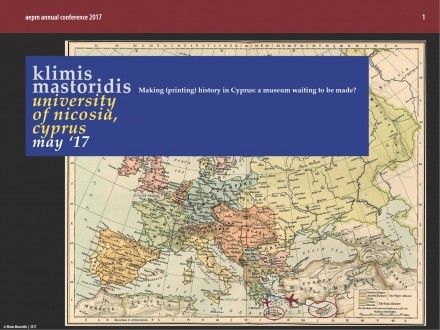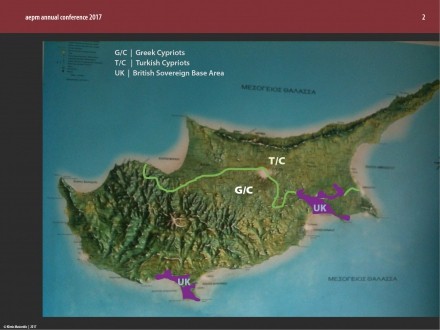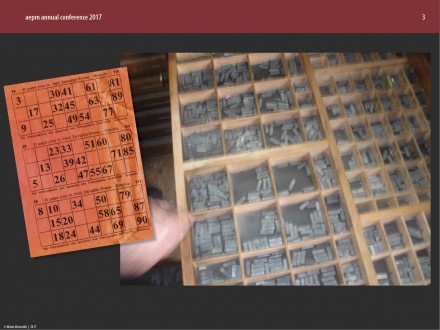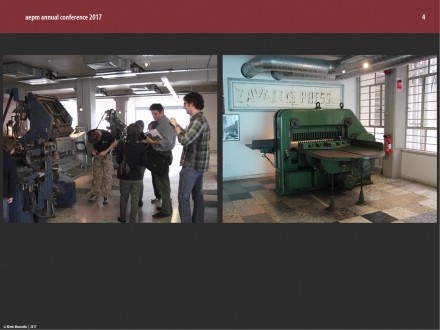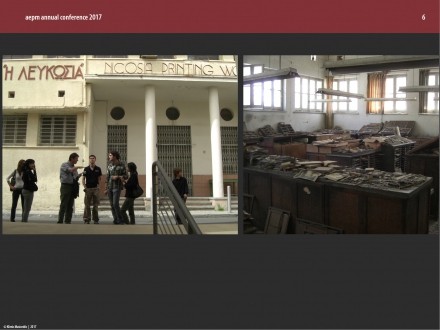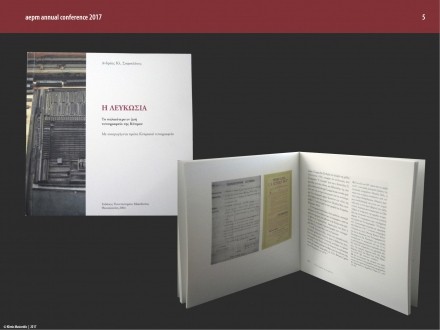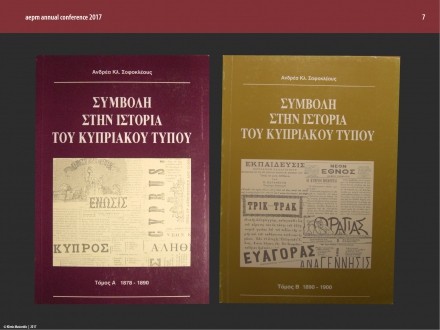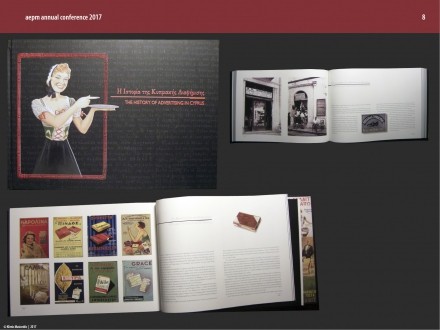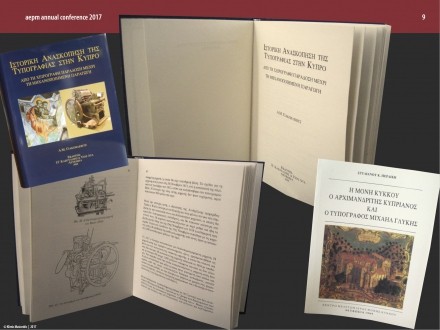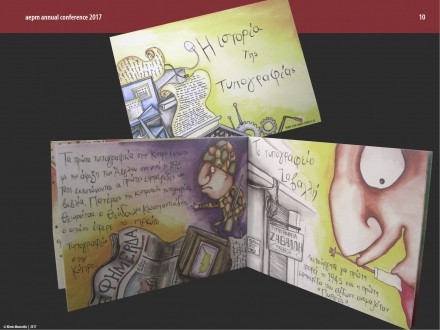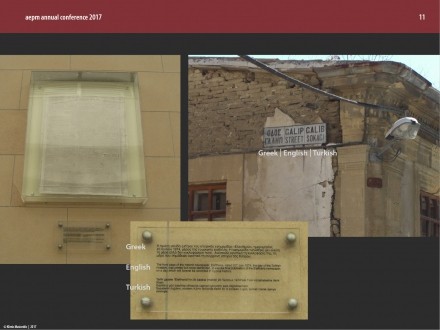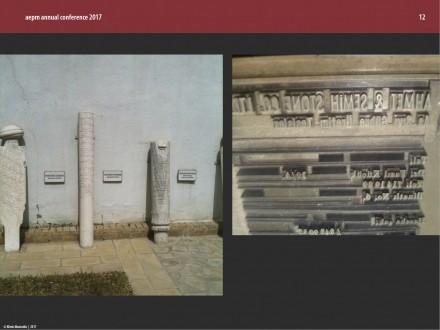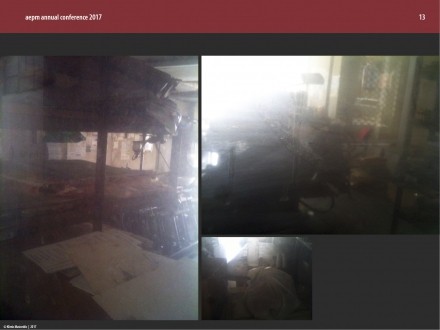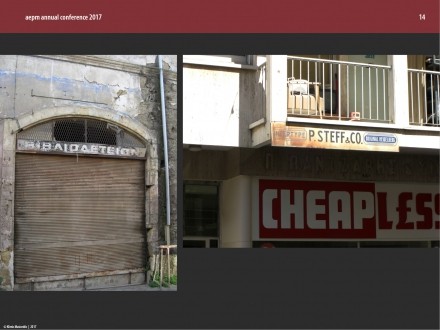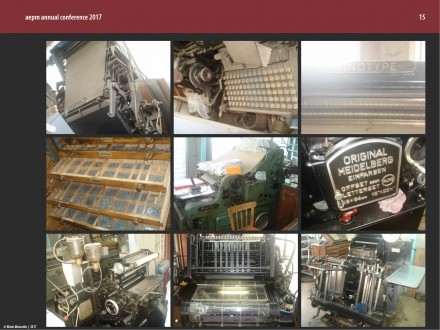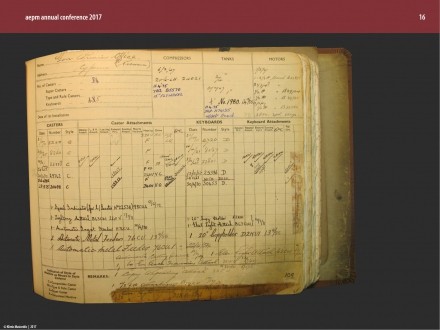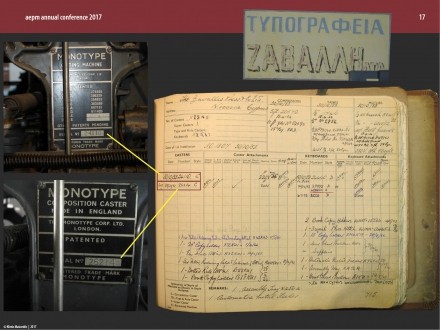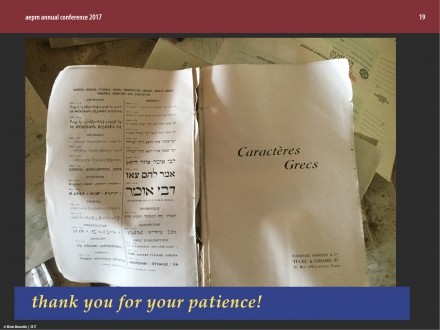Making (printing) history in Cyprus:
a museum waiting to be made?
Klimis Mastoridis, University of Nicosia, Cyprus
Text of a paper given by Klimis Mastoridis at the conference of the Association of European Printing Museums, Making history: collections, collectors and the cultural role of printing museums, Museum of Typography, Chania, (Crete, Greece), 11-14 May 2017.
Before I start I would like to thank Alan Marshall, Yannis Garedakis and Elia Koumi for having invited me to speak at the conference and for offering an opportunity to meet old, good friends. Allow me to express my sincere joy for being part of this two-day event of the Association of European Printing Museums organised in Chania, at the local (national) printing museum, an always lively and energetic space due to the hard work of its people!
Although I was asked to talk about Greece, I decided to communicate to you some of my views and ideas about the place where I have been living and working for the last ten years. There are two reasons for doing so: first, a group of Greek colleagues, well informed but also well known experts are participating in the conference and will talk about Greek printing history, museums, and collections in Greece. Second, Cyprus is a small island mostly known for its magnificent past and the role it has played in the history of the Eastern Mediterranean. With an undeciphered script from as early as 1500 BCE, an unknown indigenous language, and intriguing historical questions about writing systems that were developed to visually represent local dialects and the Greek language, Cyprus became over the centuries the centre of a long and rich multicultural tradition. But what about modern Cyprus; are there any cultural signals, relevant to our field, that CY might be able to transmit?
Initially, the title of the talk I proposed was slightly different than the one that appears on the programme; the current title was chosen at Alan’s suggestion, to which I didn’t object. My provisional title was “Cyprus: making (printing) history”, and I had a second favourite: “Can Cyprus make (printing) history”? As Alan tends to relate everything to printing museums, he added the interrogative part: “a museum waiting to be made?”. I must confess that this was the exact idea behind my presentation but I wouldn’t dare to put it on the title; it sounds like a very ambitious plan for a small place – especially, for that specific place.
Cyprus became an independent republic in August 1960; however, it has proven to be a fragile one. I won’t go into details; the fact is that after a series of political upheavals, the “Cyprus issue”, as it is known, is still open and continues to torment both the Greek Cypriot and Turkish Cypriot societies. The culmination was the Turkish invasion in the summer of 1974; it split the island into two: Greek Cypriots fled to the south and the Turkish community to the north. No settlement has been reached and Cyprus, still after 43 years, remains a divided island. [2]
I have been living there since 2007; occasionally, due to the sociopolitical environment, I have been faced with unpredictable, unexpected events – sometimes pleasant, sometimes unpleasant, sometimes pleasant and unpleasant at the same time! Here’s such a pleasant and unpleasant at the same time example: A few years ago, a Turkish Cypriot student of mine brought me a small package of unused Greek metal printing types. He was doing his work placement, a requirement for his BA in Graphic Communication degree, at a small print shop in a town in the north-western part of Cyprus, now in the occupied area. The small shop, which belonged to a Greek Cypriot printer, fell into the hands of a Turkish Cypriot in 1974; he carried on with the business but didn’t use the Greek letters. The printing types were in their original wrapping and I was invited to visit the place and get all the necessary information about his establishment. [3]
This event, together with the regular semester visits with my ‘History of graphic communication’ students to the old Zavallis Brothers printing house in the old city, triggered a process familiar to most of you; attempts at contacting old printers, make interviews and take photographs of machinery, equipment and materials still kept by them. [4, 6] In addition, work to create a comprehensive record of old and interesting items, relevant to the printing history of the island, found in collections or in printing houses still in operation. Before I go into some more details, let me say a few words about the existing bibliography and the relevant research done on the history of printing in Cyprus. About printing first:
There is one history of printing study with the title Nicosia, the oldest printing house in Cyprus. An introduction to the early Cypriot printing establishments. This 90-page book was first published in Nicosia in 2003 by Andreas Sophocleous, now Professor Emeritus of communication and mass media at the University of Nicosia. It was reprinted a year later, in 2004, with the same title by the University of Macedonia Press in Thessaloniki, Greece – at a time I was the Director of the publishing house there. In that book, the general introduction about the start of printing in Cyprus in the late 1870s and early 1880s, follows the story of the Nicolaou printing house, which, according to the author, was established in 1906. The content of the book is the outcome of the author’s long term research on the history of the Cypriot newspapers but it is also based on interviews conducted with – and material received by the Nicolaou family. A number of relevant images as well as photographs taken in the abandoned (since the 1990s) printing house, which is located in the heart of the old city, accompany the text. [5]
Professor Sophocleous’s research has spanned more than two decades and resulted in a ten-volume Contribution to the history of the Cypriot press that covers the period from 1878 to 2010. [7] In addition, an impressive (content and production wise) bilingual (Greek and English) volume, with the title The history of advertising in Cyprus, came out in 2004. [8] Attempts at printing in Cyprus are briefly discussed in both these works. Sophocleous has a new book coming out soon; its title is An outline of the chronicle of Cypriot printing. Again, it is based on his History of the press sources, on research carried out at the Cyprus Public Record Office (renamed State Archives in 1991), and on interviews with the heirs of the old printing businesses.
The only other work about printing history was compiled by Dr Andreas Jakovljevic, a Byzantine scholar and Director of the Byzantine section of the Research Centre of Kykkos Monastery based at Archangelos Monastery, Nicosia, Cyprus. As the author explained in his forward, the work was commissioned and printed by the firm I.G. Cassoulides and Son Ltd in 2006 in Nicosia. Cassoulides were also the publishers of the book, which the author dedicated to the founder of the printing company, Christakis Cassoulides (1925-2001). [9] Most of the 300 pages of that book titled Historical review of printing in Cyprus. From the manuscript tradition to mechanical production are based on secondary sources and include general information and a large number of images about the invention of printing, paper, rotary presses etc, as well as information about the printing adventures of Greeks in the West (Venice) and the East (Constantinople and Smyrna). Jakovljevic devotes a 40-page chapter (which I think is the most interesting one), to Cypriot scribes and manuscript production and concludes with information about printing in Cyprus. This last part is entirely based – as he explains – on Sophocleous’s publications; he also thanks Andreas Sophocleous for ‘having allowed’ him ‘to extensively and unconditionally use his work’.
There is also a monograph by Stylianos Perdikis about the relationship of Archbishop Kyprianos and the Kykkos monastery with the printing house of Michael Glykis in early 19th century Venice, published in 1989 by the Study Centre of the Holy Monastery of Kykkos (Περδίκης, Στυλιανός Κ., Η Μονή Κύκκου, ο Αρχιμανδρίτης Κυπριανός και ο Τυπογράφος Μιχαήλ Γλυκής, Κέντρο Μελετών Ιεράς Μονής Κύκκου, Λευκωσία 1989), a short article by Kypros Chrysanthis titled ‘Printing in Cyprus’ (Η τυπογραφία στην Κύπρο), 1956 (reprinted in 1967), and an undated 24-page landscape booklet for children (actually published in 2007) under the title The history of printing (Η ιστορία της τυπογραφίας); the text was written by the journalist Meropi Moiseos and the images were created by the illustrator Ioanna Philippou. [10]
Finally, I would like to mention here the work by Ahmet An. Paediatrician, political activist and author of various books on the Cyprus issue, An has also written a book about the T/C printing houses. Here’s part of what I received when I contacted him: ‘I have already written a book in Turkish under the title The History of the T/C Printing Houses (1878-1974), but unfortunately it is still not printed by the printing house whose owner has commissioned me to produce this work.’
This is all that has been published (well, almost, as Ahmet An’s work has not been printed yet) in relation to printing in Cyprus. But even that very limited corpus of work is problematic due to lack of necessary special knowledge about printing technology, equipment and materials. An, in his correspondence, stated: ‘I am more interested in the history of those printing houses and [I am after information] about which books and newspapers they printed’, exactly as Sophocleous was, when he started working on his Cyprus press history in 1995.
Accordingly, we can claim that the history of printing in Cyprus remains an unexplored territory, especially when it comes to the documentation of historical and practical issues related to matters that concern the originators, their tools and materials as well as their products – and to the evaluation of these as cultural commodities. But also their relationships with colleagues within the print shops, with fellow printers and external collaborators (such as bookbinders, paper and printing type suppliers, machinery importers and technicians), and the community in general. Obviously, this documentation is not an easy task for a country with two official languages, Greek and Turkish – plus English, a language that was, and still is, used in many spheres of the public life. Cyprus was under British rule from 1878 to 1960; until the 1930s three major different alphabets were employed, i.e. Greek, Latin, and Arabic (Ottoman Turkish). The latter was replaced by Latin in 1928, after a political decision by Mustafa Kemal Ataturk, a change that was delayed in Cyprus probably due to the widespread use of the dialect and the loose relationship of the Turkish Cypriot community with Turkey and Islam. [11, 12]
To the above we should also add the prevalent political situation; Greek Cypriot printing establishments, with their infrastructure, have been operated by Turkish Cypriots for more than four decades, that is, since 1974. Again, here is part of my correspondence with a Turkish Cypriot colleague: ‘I have no idea where to find old printing machines, since all printers bought new technology. As far as I know, we don’t have old printing houses; almost all are new! One of the oldest ones moved some years ago having acquired new machinery. You have to try to contact old printers, however there is no tradition of keeping the old machines. Still, every year we sell old scrap metal to Turkey – remaining from the Greek Cypriots and others!’
In the past I have mostly visited and searched printing establishments in Nicosia, the capital of the Cyprus Republic. Although still a divided city, the centre of the old town in the Greek Cypriot territory – after decades of decline and abandonment – has recently started to regain its old fame. There is a rapid process of change, whose positive aspects no one can doubt. However, for what I discuss here, there will be negative consequences too. The abandoned print shop (‘kalitechnikon’ as it is known in Greece), that I photographed somewhere in the old city three years ago, has disappeared with all its contents. [13]
Sometimes, only the rusty shop signs indicate that there used to be a print-related business. [14] Let me open a parenthesis here just to say that nobody actually knows what exists on the other side. Old, rare books and ephemera appear from time to time in classes, and photographs of printing machinery and equipment come into my hands from old and new students who live in the north. Despite the certainty of my colleague about the disappearance of old printing machinery and equipment, I still believe that interesting artefacts might be discovered there too. [15]
In Nicosia I have discussed with owners of small and large, idle and running print shops; I have taken photographs and videos, and have tried to identify and create a record of a number of printing presses, auxiliary equipment, machinery and documents. Moreover, being particularly interested in the history and use of Monotype setters and casters in Cyprus, and having searched the London Type Museum archives, I am now trying to identify and record as many Monotype units as possible – plus any relevant peripheral items, from keyboards to typespecimens. [16, 17]
This brings me to the last part of what I have to present this evening to you, or rather to last before one. For the last part of my presentation is a seven-minute video; it is a compilation of images – only a tiny fraction of the data I have collected up to now. The aim is to clearly communicate that the necessary material for a museum of printing in Cyprus exists. Sleeping artefacts scattered in Nicosia and in other cities, like Larnaca and Limassol for example, the other two printing centres of Cyprus, are waiting for a living museum to wake them up, exactly as the Chania Museum did here in Greece. So, yes, Alan was right!
The long term plan is to create a space that could stage an operational, hands-on display; an open environment for visitors from different countries and of all ages; an educational facility but at the same time an entertainment hub where printing artefacts would engage participation through innovative approaches. Discussions with interested parties have started; one of the main aims is to bring together those who approach this project with the scale and the seriousness it deserves. Most of you know well that this is a huge task. I am not entirely against the ‘think big’ approach; in my view, however, long-term commitments need effective short-term, step by step planning. We now need to compile a substantial digital inventory of items found in old printing houses, public and private collections in both, the south and the north, through an identification and documentation process. To this end, we have to go on trying to secure funding that will enable us to move forward and maintain positive momentum. This is a prerequisite for the next stage. I really hope that we’ll be able to present that and discuss it with you – as well as further, ‘next stages’ at the 2018 AEPM conference!
Special thanks to Chr. Nicolaou & Sons Ltd, H. Kiriakides, V. Kokkinou, N. Zavallis Flexo, G. Frangos, President of the Union of Cyprus Journalists, M. Moiseos and Politis newspaper, D. Avery and the Type Archive, London.
Thanks are also due to Prof. Andreas Cl. Sophocleous, Dr Ahmet An, Stelios Irakleous, Dr Mary Dyson and Dr Niki Sioki.
